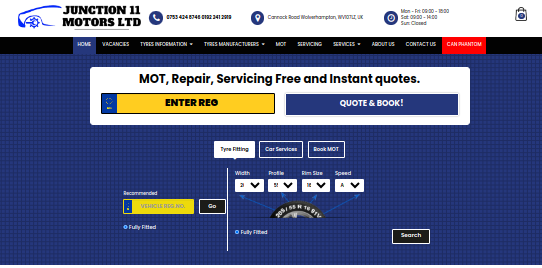Reasons Behind Unusual Vibrations After Fitting A New Tyre

When you install new tyres in your vehicle, most of you notice some unusual vibrations while driving the vehicle. This can be surprising, especially if the car was smooth before you got your tyres changed. These vibrations can be a sign that something needs adjustment or attention. It is crucial to figure out the issue to ensure your car runs smoothly and safely. In the following blog, we will talk about why the vehicle vibrates after a new tyre installation. The correct analysis will help you fix the problem quickly and confidently get you back on the road.
Bad Alignment
The most important and common reason for vibrations when installing a new tyre is the improper wheel alignment. The wheel alignment refers to the angle at which the wheel meets the road. If the wheels do not align well, the tyres will wear unevenly and vibrate your car. This is because the tyres will try to make a grip on the road at different angles, which causes the vehicle to shake. When installing the new tyres, checking the alignment before it escalates to a major issue is good. Get the wheels adjusted to avoid uneven wear and vibrations.
Unequal Tyres
The unbalanced tyres can also be a factor that causes the unusual vibrations. The tyres which are not appropriately balanced will not rotate smoothly. This causes the vehicle to shake, significantly at higher speeds. It is essential to balance the tyres and wheel combination that has the correct weight distribution. Tyres Newtown usually balances the tyres when you get them fixed and installs them. This may not get it perfect. If you feel the vibrations after changing the tyre, it is good to get it rebalanced.
Issues While Installing
Vibrations can be caused by tyres that are not installed correctly. Sometimes, while fitting the tyres, the lug nuts may be unable to hold them in place, and the tyres may not be fixed to that limit. If the lug nuts are too loose, it can cause the tyres to move slightly when you drive at a straight position. It is important to ensure the tyres are correctly mounted and lug nuts are fixed to get the correct torque. You should get it checked by a professional if you have any doubts about the installation.
Blemish Tyres
The new tyres might have some defects or damage, but they are not visible at first. If one new tyre has a problem like a bulge or weak spots, this causes vibrations while driving. This is more common with the cheaper tyres, which can happen with any brand. If the driver notices some unusual vibration after installing new tyres, they must check the visible damage to avoid it. If you still find anything unusual, return your tyres to the shop where you purchased them or replace them as soon as possible.
Twisted Rotors
The vibrations sometimes happen not because of something wrong with the tyres, but because of a problem with the brake rotors. This component is like a metal disc that presses the brakes to stop the car. If the rotors seem warped or uneven, this elevates the feeling of shaking or vibrations while engaging the brakes. The technician might touch the brakes while installing the new Car Tyres Wolverhampton, although this issue is not directly connected to the tyres. If you notice these unusual vibrations while stopping the vehicle, this might indicate that there is something wrong with the brake rotors.
Flat Spots on Them
Flat spots happen when you sit in one place for a prolonged period. This happens especially when you are driving a car with under-inflated tyres. These flat tyre spots are the areas where the surface appears to be worn or flattened. When you go to the tyre shop to get the new tyres installed, the flat spots on the old ones can still cause vibrations if they are not removed. This is the most common issue with old tyres. This can sometimes affect the new tyres if you are not using your vehicle for a long time, and driving correctly before installing them.
Abnormal Pressure
You might be experiencing vibrations because of improper tyre pressure, or if the tyres are overinflated or underinflated. When you install new tyres, they need the proper inflation to match the recommended pressure. The abnormal pressure can lead to some annoying vibrations and may affect the driving scenario. Underinflated tyres cause more friction, whereas overinflated tyres create an uneven surface, which leads to vibrations. It is necessary to check the tyre pressure regularly and to ensure they have the correct amount of pressure.
Sum It Up
The issues we have discussed cause vibrations after installing the new tyre. If you notice any unusual shaking or vibrations, take your vehicle to a genuine garage or service provider. A professional check can solve this issue and ensure the safety of your car. The proper attention and care can get you back on the road smoothly and early.
